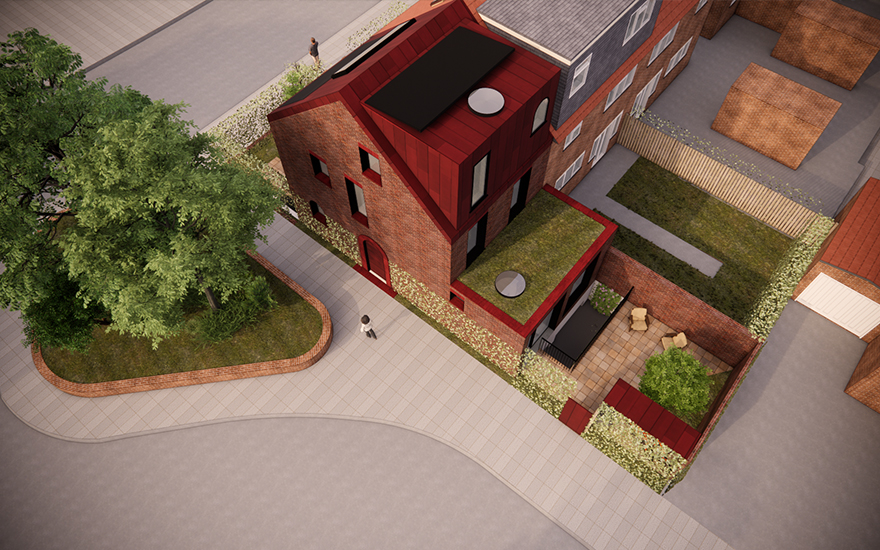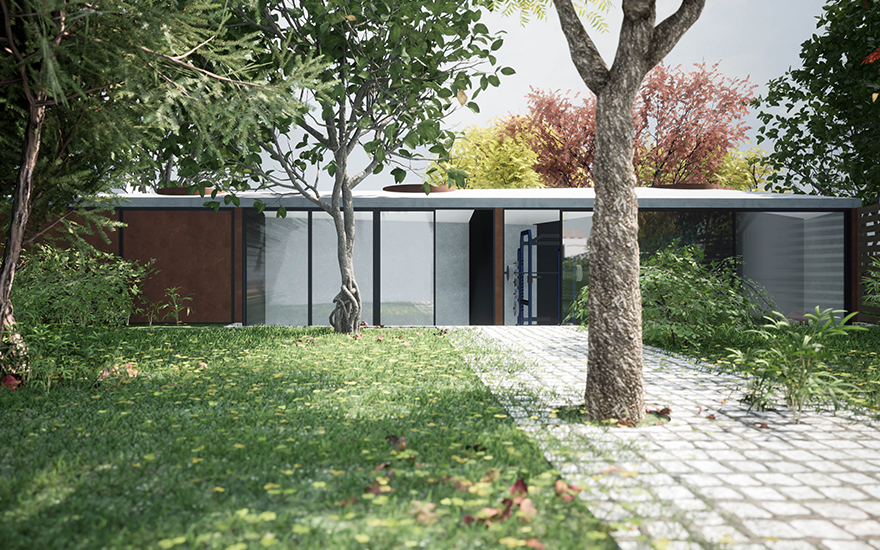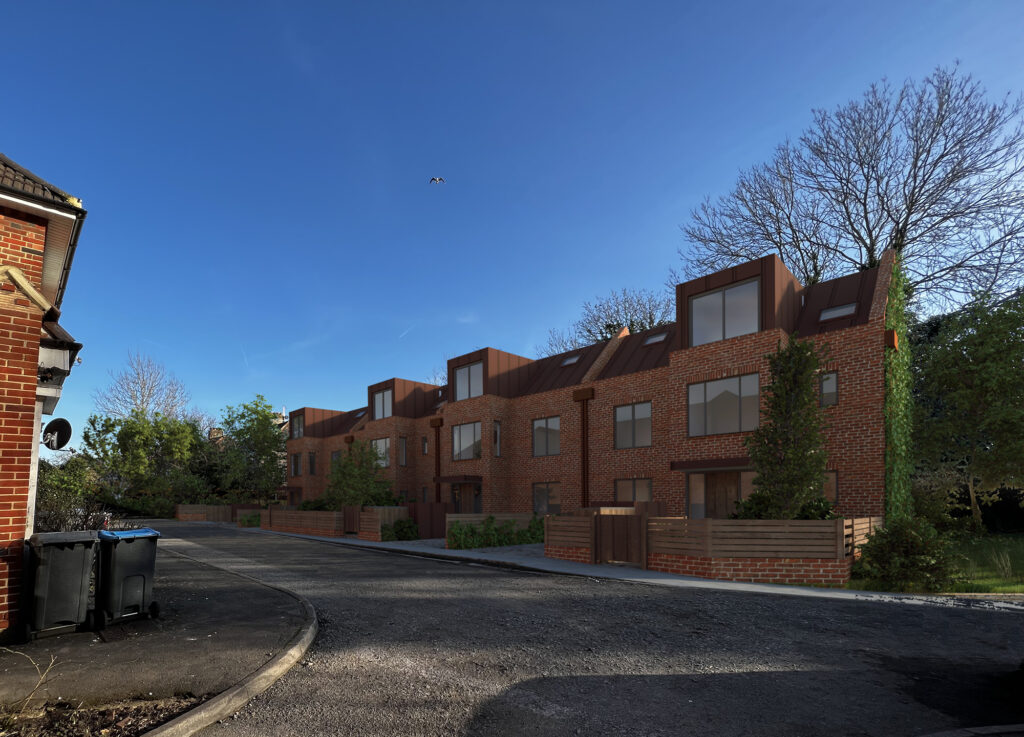Nestled within the confines of our contemporary urban sprawl lies an opportunity, often overlooked – the realm of the backlands plot. As an architect with two decades of experience leading a boutique, design-focused architecture studio, my journey has led me to deeply appreciate the charm and potential of backlands development. Our studio, passionate about pioneering sustainable and low embodied carbon designs, has been navigating the intricacies of backlands planning with a discerning and innovative eye, and I’m eager to share our insights and experiences with you.

Decoding the Backlands Puzzle
The backlands plot, a parcel of land situated at the rear or side of an existing property, can be an architectural gem in the making. Frequently a sizeable portion of a sprawling garden, these plots are often secluded from the bustling roads encapsulating them. The charm lies in their potential, large enough to cradle a new dwelling yet intrinsically private due to their positioning.
Historically, the practice of exploiting these plots was pejoratively referred to as ‘garden grabbing’, meeting opposition from local authorities. However, the lens through which we view these plots has transformed significantly in recent years. In our quest to fulfil housing needs in increasingly saturated environments, backlands development has emerged as a sensible and innovative strategy, enabling an escalation in housing density without expanding the urban footprint.
Such plots are a canvas for self-builders eager to create their dream abode on land they already own. However, treading the path of backlands planning isn’t without its hurdles. That said, a comprehensive application that anticipates and addresses pertinent concerns significantly heightens the odds of success.

Navigating the Labyrinth of Backlands Development
Embarking on a backlands project is akin to setting foot on a thrilling architectural expedition, punctuated by challenges to be surmounted. These hurdles revolve primarily around accessibility and the dynamics with neighbouring properties, though other considerations involving space, privacy, and design are of substantial significance.
A cardinal rule for a backlands plot to be planning-compliant is the availability of direct access to the road. This could be via a boundary fence, a discreet alleyway, or an access road. Ownership of the access pathway considerably simplifies matters when submitting the planning application.
Neighbourly relations can be a double-edged sword in backlands developments. Neighbours might view a new construction within their surroundings as intrusive, leading to potential opposition. However, objections can be mitigated if it can be convincingly demonstrated that the planning policies have been scrupulously followed, and that the development will not significantly impinge on the views or light entitlements of the neighbours.
Space and privacy are intertwined in the considerations that govern the success of backlands development. The proposed home must have sufficient space to breathe, avoiding a congested feel and aligning with the spacing pattern of the surrounding homes. Privacy is an integral part of this equation, with the plot location and proximity to neighbouring properties being critical elements.
Design, the backbone of our architectural vision, holds the key to successfully unlocking backlands plots. The constraints notwithstanding, creating a design that harmoniously balances your aspirations and the stipulations of the planning authorities can be a thrilling architectural challenge. The form and materials of the proposed structure may be dictated by the location, whether it involves adhering to a single-storey restriction to preserve view corridors or incorporating vernacular materials to harmonise with the local aesthetic.

Unlocking Success in Backlands Planning: A Guided Approach
Each planning authority has its own unique regulations and policies, making the expertise of an architect well-versed in backlands planning applications invaluable. Coupled with the insights of a planning consultant, their collective wisdom can pave the way for a successful application. While local area experience is beneficial, the core understanding needed is of backlands plots and their inherent constraints.
Here are some nuggets of wisdom for navigating backlands development:
- Engage an experienced designer to guide your journey.
- Keep your neighbours informed and involved from the outset to anticipate potential issues and defuse any brewing confrontations.
- Undertake a planning pre-application to obtain expert advice and insights on potential challenges.
- Strive to create a sustainable, future-proof home. The environmental advantages carry significant weight.
- Demonstrate how the development will enhance the utilisation of the land.
Backlands Planning: A Case Study from North West London
One of our recent backlands planning applications and approvals involved an underused side garden situated close to a Conservation Area. Owing to the contentious nature of backlands plot applications, we embarked on a pre-application process to identify potential hurdles from the perspective of the local authority.
The pre-application advice is a fundamental part of the process, particularly for projects involving virgin sites or those seeking to establish key principles for site development before delving deep into the design process. This stage can be time-intensive but yields invaluable feedback from the local planning authority, providing clarity on the project’s viability and the likelihood of their support for your proposal.
This particular site already enjoyed road access, thanks to it being located at the side of a semi-detached plot enclosed by two roads. Additionally, the trees populating the pavement immediately adjacent to the site provided a natural screen, minimising visibility from neighbouring properties and ensuring no adverse impact on their views or light entitlements.
Contemplating a Backlands Adventure?
Are you intrigued by the prospect of transforming a backlands plot into a dream dwelling? Our experienced team at the studio would be delighted to guide you on this rewarding journey.
Frequently Asked Questions
- What is backlands planning permission?
- Backlands planning permission refers to the process of obtaining approval to build a new home on a piece of land located at the back or side of an existing property, often within a large garden. It involves submitting a well-rounded planning application that addresses various considerations and potential barriers.
- Why has backlands development become more acceptable in recent years?
- Backlands development, previously known as “garden grabbing,” is now viewed as a more acceptable way to address housing needs by increasing the density of houses in built-up areas. Local authorities have shifted their stance, considering it a viable option for self-builders to create new homes on land they already own.
- What are the main challenges of a backlands project?
- The main challenges of a backlands project are access and neighbours. Other factors to consider include space, privacy, and design. Access to the road is crucial, either through a boundary fence, an alleyway, or an access road. Neighbours often oppose such developments, but objections can be overcome by demonstrating compliance with planning policies and minimal impact on views and rights to light.
- How can I ensure my backlands plot is planning friendly?
- To make your backlands plot planning friendly, it should have direct access to the road, either through a boundary fence or an alleyway/access road. If you own the access, it simplifies the planning application process. Additionally, the proposed home should have adequate space around it to avoid a cramped feel and maintain the pattern of surrounding homes.
- What role does design play in backlands plots?
- Design is crucial for backlands plots, as a well-thought-out and sensitive scheme can help overcome many of the challenges mentioned earlier. Design considerations may involve adhering to specific constraints, such as maintaining certain views or using materials that blend with the area’s character.
- Should I hire professionals for backlands planning applications?
- Yes, it is recommended to hire an architect with experience in backlands planning applications and consider using a planning consultant. Their expertise will ensure you are better prepared for success, considering the unique regulations and policies of each planning authority.
- How can I address concerns from neighbours in a backlands project?
- Keeping neighbours informed from the start and addressing their concerns can help avoid potential contests during the planning process. Maintaining open communication and considering their perspectives can help foster understanding and minimise conflicts.
- What is a planning pre-application, and why is it important for backlands projects?
- A planning pre-application is a stage in the planning process where you seek advice and insights from the local planning authority before fully developing your design. It helps establish fundamental principles and gather feedback on the viability and support for your project. Pre-applications are particularly important for projects in new spots or areas where there hasn’t been a home before.
- How can I demonstrate the benefits of my backlands development?
- To prove that your backlands development will improve the use of the land, you can focus on creating a sustainable and future-proof home. Highlighting the environmental benefits and showcasing how the development aligns with land use objectives can strengthen your case.
- Can you provide an example of a successful backlands planning application?
- In a recent backlands planning application in North West London, a new dwelling was proposed on an underused side garden close to a Conservation Area. The site already had access from the road, and the new home was strategically concealed by neighbouring council trees, ensuring minimal impact on neighbours’ views and rights to light. See here for more details.
If you would like to talk through your project with the team, please do get in touch at mail@risedesignstudio.co.uk or give us a call on 020 3290 1003
RISE Design Studio Architects company reg no: 08129708 VAT no: GB158316403 © RISE Design Studio. Trading since 2011.
